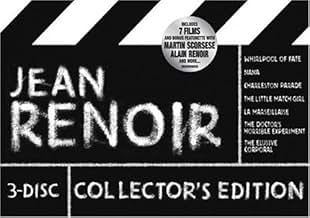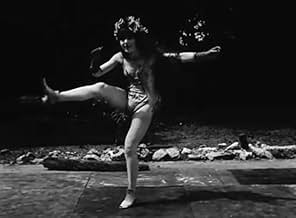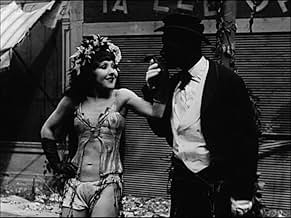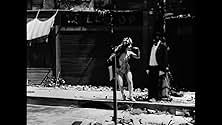AVALIAÇÃO DA IMDb
5,9/10
752
SUA AVALIAÇÃO
Adicionar um enredo no seu idiomaShot in three days, this surreal, silent short shows a native white girl teaching a futuristic African airman the Charleston dance.Shot in three days, this surreal, silent short shows a native white girl teaching a futuristic African airman the Charleston dance.Shot in three days, this surreal, silent short shows a native white girl teaching a futuristic African airman the Charleston dance.
- Direção
- Roteiristas
- Artistas
- Direção
- Roteiristas
- Elenco e equipe completos
- Produção, bilheteria e muito mais no IMDbPro
Avaliações em destaque
A man in blackface lands in a spaceship and meets a girl who lives in some sort of shack with a monkey. He hooks her up with a telephone, and she teaches him how to Charleston. Then they fly off in the spaceship, leaving the monkey behind. Cringe-inducing blackface aside, this short film makes no sense. I think that's the plot, but I'm not sure by a long shot. You can't tell that this is Renoir at work, despite his characteristic humanism. Good use of slow-motion, though. Can be found on the NY Film Annex's series of Experimental Film videos, No. 18, I believe.
Charleston Parade (1927)
** 1/2 (out of 4)
Extremely bizarre short film from Jean Renoir is somewhat sci-fi and somewhat musical. A man in blackface takes off in a spaceship and lands in an unknown country. In this country he meets a white woman (Catherine Hessling; the director's wife) who does a tribal dance, which the blackface man believes is from his native people. I'm really not sure what the hell this film is suppose to be about but I can only guess it has something to do with reverse racism. There are several racial comments made by the white girl and her "not liking black meat" and I guess her being the "native" doing a tribal dance was the reverse thing from the black man doing it, which is something we've seen in countless films from this period. The DVD doesn't feature any music score so it was somewhat hard to know the nature the director was going for. An interesting short to say the least.
** 1/2 (out of 4)
Extremely bizarre short film from Jean Renoir is somewhat sci-fi and somewhat musical. A man in blackface takes off in a spaceship and lands in an unknown country. In this country he meets a white woman (Catherine Hessling; the director's wife) who does a tribal dance, which the blackface man believes is from his native people. I'm really not sure what the hell this film is suppose to be about but I can only guess it has something to do with reverse racism. There are several racial comments made by the white girl and her "not liking black meat" and I guess her being the "native" doing a tribal dance was the reverse thing from the black man doing it, which is something we've seen in countless films from this period. The DVD doesn't feature any music score so it was somewhat hard to know the nature the director was going for. An interesting short to say the least.
Shot in three days on a practically zero budget, using film stock left over from Nana, Jean Renoir made this strange curio just for fun. He never edited it. It was never released. He later gave the footage to the Cinémathèque Française, who pieced the film together.
The story: it's the year 2028. An explorer from Central Africa (Johnny Huggins, a jazz dancer of the 1920s, who appears here in minstrel makeup; he actually was black) arrives in a post-apocalyptic Paris in a flying sphere. He encounters a scantily-clad wild girl and her monkey friend. The girl dances the Charleston to try to seduce him. He thinks she's threatening him and he runs away. She chases after him, dancing ever more aggressively and seductively. The explorer begins to watch, hesitantly, but curiously. The girl draws a telephone on the wall, which turns into a real telephone, and she calls some kind of disembodied human head with wings. Some other winged disembodied heads appear. The girl hands the phone to the explorer, and one of the heads speaks to him--apparently letting him know that the girl's OK. Then the explorer and the girl dance the Charleston together. The girl leaves with the explorer in his flying sphere, her tearful monkey friend waving goodbye.
The story: it's the year 2028. An explorer from Central Africa (Johnny Huggins, a jazz dancer of the 1920s, who appears here in minstrel makeup; he actually was black) arrives in a post-apocalyptic Paris in a flying sphere. He encounters a scantily-clad wild girl and her monkey friend. The girl dances the Charleston to try to seduce him. He thinks she's threatening him and he runs away. She chases after him, dancing ever more aggressively and seductively. The explorer begins to watch, hesitantly, but curiously. The girl draws a telephone on the wall, which turns into a real telephone, and she calls some kind of disembodied human head with wings. Some other winged disembodied heads appear. The girl hands the phone to the explorer, and one of the heads speaks to him--apparently letting him know that the girl's OK. Then the explorer and the girl dance the Charleston together. The girl leaves with the explorer in his flying sphere, her tearful monkey friend waving goodbye.
I enjoy science-fiction just as much as the next man
but what the hell was that? Apparently shot over just three days using excess film stock left over from his previous film, 'Nana (1926),' this Jean Renoir short is a bewildering futuristic satire, produced on a budget that couldn't have been much more than zero. In the year 2028, following a great war, Africa has become the most civilised region on Earth, and what was formerly Europe has been designated "Terres Inconnues (Unknown Land)." An African explorer played by Johnny Huggins, a Black man dressed up as a White man dressed up as a Black man, if you follow me travels to the ruins of Paris in his spherical aircraft, and lands outside the lair of a Parisian savage (Catherine Hessling, then the director's wife) and her primate companion, perhaps the creepiest ape-man costume I've ever seen. The savage, as part of some bizarre sexual initiation ritual, starts showing the explorer the Charleston dance, which he is delighted to learn himself.
It doesn't help the film that Hessling, who was wonderful the following year in Renoir's 'The Little Match Girl (1928),' isn't much of a dancer, though the extensive use of slow-motion adds a touch of surrealism to the ceremony. Furthermore, I'm quite shocked that Renoir would exploit his own wife as such a blatant sexual object it doesn't come as a surprise to learn of their divorce just three years later! On the plus side, I did like the general sci-fi concept behind the film, and the slyly satiric touch of the reversing the racial roles usually typical in such stories as this. However, why Renoir decided to dress up his Black actor as a minstrel will remain a mystery for all of time. Silly, crude and quite pointless, 'Charleston Parade (1927)' is a cinematic oddity from one of cinema's most respected directors, and is perhaps an effort that he would have liked to forget. The DVD version came without a musical soundtrack, but I compromised with a selection of pieces from Dmitri Shostakovich.
It doesn't help the film that Hessling, who was wonderful the following year in Renoir's 'The Little Match Girl (1928),' isn't much of a dancer, though the extensive use of slow-motion adds a touch of surrealism to the ceremony. Furthermore, I'm quite shocked that Renoir would exploit his own wife as such a blatant sexual object it doesn't come as a surprise to learn of their divorce just three years later! On the plus side, I did like the general sci-fi concept behind the film, and the slyly satiric touch of the reversing the racial roles usually typical in such stories as this. However, why Renoir decided to dress up his Black actor as a minstrel will remain a mystery for all of time. Silly, crude and quite pointless, 'Charleston Parade (1927)' is a cinematic oddity from one of cinema's most respected directors, and is perhaps an effort that he would have liked to forget. The DVD version came without a musical soundtrack, but I compromised with a selection of pieces from Dmitri Shostakovich.
As a closet completist I felt I must see this one, even though what I knew about it wasn't prepossessing. And the result: a piece of exuberant tosh by Renoir - the classics were definitely a long way off.
In 2028 black-faced Negro flies in to Terra Incognito - post War France - in a sphere and is ensnared by an indefatigable dancing scantily clad white aborigine woman. Although he too has a sense of rhythm he's especially impressed by her either dancing first in slow- and then fast-mo. Slinky and shameless dance moves, a telephone drawn on the wall and 5 bodiless grinning angels are highlights - give me Tex Avery anyday! Hessling was certainly good to look at (personally speaking of course) but even though it's so short it still drags without a coherent plot.
But! This wasn't meant to be heavy, and as knockabout sci-fi it was an interesting 19 minutes - I might even watch it again sometime.
In 2028 black-faced Negro flies in to Terra Incognito - post War France - in a sphere and is ensnared by an indefatigable dancing scantily clad white aborigine woman. Although he too has a sense of rhythm he's especially impressed by her either dancing first in slow- and then fast-mo. Slinky and shameless dance moves, a telephone drawn on the wall and 5 bodiless grinning angels are highlights - give me Tex Avery anyday! Hessling was certainly good to look at (personally speaking of course) but even though it's so short it still drags without a coherent plot.
But! This wasn't meant to be heavy, and as knockabout sci-fi it was an interesting 19 minutes - I might even watch it again sometime.
Você sabia?
- CuriosidadesJean Renoir's debut as an actor.
- ConexõesFeatured in Jean Renoir: Part One - From La Belle Époque to World War II (1993)
Principais escolhas
Faça login para avaliar e ver a lista de recomendações personalizadas
Detalhes
- Tempo de duração17 minutos
- Cor
- Mixagem de som
- Proporção
- 1.33 : 1
Contribua para esta página
Sugerir uma alteração ou adicionar conteúdo ausente

Principal brecha
By what name was Charleston (1927) officially released in Canada in English?
Responda

















